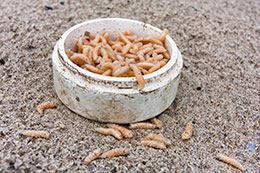- News
- Horse Racing
- Racing Preview
- AQHA Racing Challenge
- Breeding
- Sales
- Quick Stakes Results
- Detail Race Results
- Qualifiers
- Leader Board
- Leading Sires
- Videos
- Auction Leaders
- Q-Racing
Streaming Video
© iStock

JULY 30, 2025–New World screwworm (NWS) is a dangerous parasitic fly that targets warm-blooded animals, including horses. Its larvae infest living tissue by burrowing into open wounds or soft areas such as the eyes, navel, genital region, or healing sites from castration or branding. Once the larvae hatch, they feed aggressively on live flesh, creating deep, expanding wounds that emit a foul odor and, if left untreated, can lead to severe tissue damage or death.
Equine are especially vulnerable during routine procedures or when suffering minor skin breaks. Infested horses may show signs of agitation, excessive head shaking, or attempts to bite or lick at wounds. Maggots are often visible within days, and a strong smell of decaying flesh may accompany the infestation. Affected animals often stop eating, isolate themselves, and become lethargic.
New World screwworms reproduce quickly. Female flies lay up to 300 eggs at a time, and the full life cycle—from egg to adult fly—can be completed in as little as 10 days. Once mature, adult flies can travel over 10 miles seeking new hosts. Wind currents and the movement of infested animals further accelerate the spread.
The only proven method of eradicating NWS is the sterile insect technique. This approach involves releasing radiation-sterilized male flies to mate with wild females, which then lay infertile eggs. This strategy successfully eliminated NWS from the U.S. in 1966 and has been maintained through a barrier zone in Panama since 2006. However, a resurgence of cases in Central America and Mexico in 2023 has prompted renewed containment efforts, including the recent launch of a sterile fly dispersal facility at Moore Airfield Base in South Texas.
Any suspected NWS infestation must be reported to the appropriate authorities within 24 hours. Horse owners and caretakers should monitor animals closely for unusual wound activity, especially during periods of high fly pressure. Immediate veterinary care is essential, both for treatment and for submitting larvae samples to confirm diagnosis. Until USDA-approved pesticides are designated for use, the best defense remains constant surveillance, early intervention, and rapid reporting.
New World screwworm is not yet in Texas. However, landowner, livestock, equine and wildlife groups understand the devastation the pest can cause. The Screwworm Coalition of Texas is directing the public to trusted resources, including permanent solutions to eradicate New World screwworm through sterile insect technique. This public information is available at screwwormtx.org
CLICK HERE for more information from the Screwworm Coalition of Texas.
The Screwworm Coalition of Texas
The Screwworm Coalition of Texas is a joint initiative organized in May 2025 comprised of livestock, wildlife, equine and landowner groups inclusive of: East Foundation, Independent Cattlemen’s Association of Texas, Livestock Marketing Association of Texas, South Texans’ Property Rights Association, Texas & Southwestern Cattle Raisers Association, Texas Association of Dairymen, Texas Cattle Feeders Association, Texas Farm Bureau, Texas Pork Producers Association, Texas Poultry Federation, Texas Quarter Horse Association, Texas Sheep and Goat Raisers Association, and Texas Wildlife Association. The coalition will ensure consistent and accurate information is shared with Texas landowners and the agricultural and wildlife industries, including tools and resources that equip Texans with educational information needed amid the threat of the NWS.

 Newsletters
Newsletters Facebook
Facebook